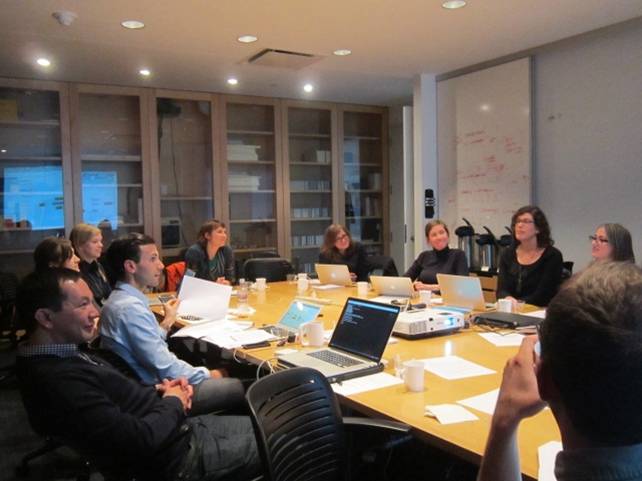About Digital Preservation: Sustaining Media Art
Digital Preservation: Sustaining Media Art is a practical on-line information resource designed specifically to support collectors, artists, and institutions large and small, in the care of their media artworks. It is a project within the larger Matters in Media Art Initiative. This most recent project addresses the challenges of establishing the infrastructure and workflows for digital artworks, specifically digital video.
A community consultation taking place in New York
It is often difficult for those with digital preservation requirements to gain access to and entry to the information needed; much of the language and the discussions are highly specialised and belong to alien communities of practice. Even within large art museums, the conservation of digital material is likely to be only one task that staff are engaged in. Digital Preservation: Sustaining Media Art responds to a need for this information to be translated to provide more accessible entry points to be able to start preserving digital collections. Digital Preservation: Sustaining Media Art is explicitly designed to be accessible to a range of audiences; addressing the needs of collectors, artists, smaller museums and galleries as well as larger institutions.
Matters in Media Art is the outcome of an interdisciplinary collaboration between three institutions; the Museum of Modern Art in New York, San Francisco Museum of Modern Art and Tate in the UK. The initiative is supported by the New Art Trust which was founded by the collectors, Pamela and Richard Kramlich, with the goal of advancing media arts through the support of research and scholarship in the field.
April 2009 saw the beginning of this latest project in the Matters in Media Art Initiative, focussing specifically on digital preservation. In 2009 all three partner institutions shared the challenge of moving to a file-based environment for the preservation, storage and display of their digital artworks. Recognising the value of addressing these needs collaboratively, it was decided to identify this as an excellent focus for a new project Digital Preservation: Sustaining Media Art. The urgent and growing need for resources addressing the care and management of digital media artworks for the broader art community was also strongly evidenced from the increasing number of telephone calls, from artists, collectors and other institutions, contacting the museums to ask for advice and support.
Key points of the work and Main Achievements
Within contemporary art museums an increasing number of media artworks are entering collections as born-digital files. Digital video also needs to be migrated from digital video tape onto file based formats as older tape formats become obsolete. None of the three institutions anticipated the scale of the challenge when they began this work almost ten years ago. At this point there were few tools available to the museum community and little awareness of the new relationships that would be needed between conservation and curatorial departments and those who develop IT infrastructure. The focus of this phase of the project has therefore been the development of infrastructure and workflows for the storage of digital artworks as files.
Fundamental to the project iss the principle of joint authorship and shared learning. Efforts have therefore been made to abstract away from the specific contributions of individual institutions to create something which addresses the needs of the broader community. Digital Preservation: Sustaining Media Art is essentially a digital resource designed for those who are engaged with the conservation of digital artworks. Written in non-technical language addressing three audiences; larger museums and galleries, smaller instituions or large private collections, and individual artists or small collectors.
The Content
The outcomes of the Digital Preservation: Sustaining Media Art project has produced newly published content related to digital artworks that is found under the 'Digital Preservation' and 'Documentation' tabs on the Matters in Media Art Website: http://mattersinmediaart.org/sustaining-your-collection.html
Those using the resource are invited to begin by reviewing the natureof their collection and to understand more about their context by answering a survey: http://mattersinmediaart.org/downloads/Survey_Scoping-your-collection.pdf
Information is then provided on how to design appropriate storgae and workflows. Additional resources such as simple downloadable spreadsheets help users to construct a budget: http:mattersinmediaart.or/sustaining-your-collection.html
At each point the resource discusses tailoring the type of system that might be needed depending on the size and complexity of the collection and the resources available. Key information is provided regarding colection management systems as well as core concepts such as 'fixity.' Within the 'Documenatation' tab, the resource describes the key components needed to set up an assesments workstation, how to assess files and carry out an initial technical analysis with options to gain more technical detail where required. Efforts have been made to ensure that the site is written in non-technical language with quotes provided by those representing the different scales of operation - from the artist, the collector as well as different scales of organisation.
Methodology & Collaboration
Collaboration has been a key component of this project both between the project team, internally within the museums and externally with the broader community that the project aims to serve. Internally, the digital preservation of artworks has required greater collaboration across departments. This phase has also provided a unique opportunity to connect those working in the Information Systems Departments within the three museums. Within the project team the geographical spread has meant the project has been delivered through meetings largely held online either to co-author content or comment. This phase had two face to face meetings, one larger project meeting at the start in 2010 involving artists and information systems team members as well as the core team; and one smaller meeting in 2012.
An Open Source Community Resource
In this phase, led by Ben Fino-Radin the site has moved from Tate's website onto GitHub in order to invite greater participation by the community; supporting improved management of open source contributions. To test the site we conducted 8 guided usability tests with random users through usertesting.com prior to review by 19 representative target users.
- Find out more: http://mattersinmediaart.org/about.html































































































































